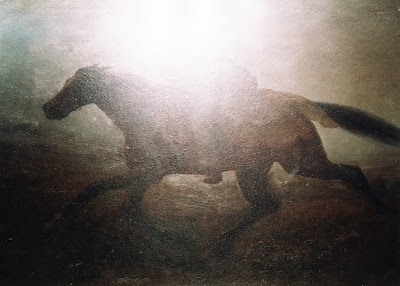Tim Davis
Sunday, 25 April 2010
Work from Permanent Collection (writing from The New Antiquity).
“You are standing in a field in Italy, looking at a pile of rocks. They are unremarkable, rutting out the ground like any gentle reminder that we live on something called a “crust.” You’ve seen rocks and these are rocks. But someone else—a friend, a guidebook, a scholar—sees a temple, an Etruscan temple of characteristic proportions carved from something called “tufa” and consecrated to Fufluns, a wine god. You don’t exactly see a temple, but sense that these rocks—as integral to the ecosystem of any vacant Roman lot as seasonal chicory and perennial used condoms—are suddenly significant. They mean something they stubbornly refused to mean minutes before.
The more time I spent in Italy, the more interested I became in that forceful shift of attention, and wondered if it could occur outside its ancient sites. I began haunting the periphery of Rome, its modern suburbs and interstitial landscapes, outside the ring road and down highway grades, places that looked more like New Jersey than Napoli. I would march into gypsy camps and factories that made dental inserts. I once crossed two overpasses to photograph a giant glowing sign that said “MOTEL BOOMERANG.” I photographed objects and people and situations and landscapes, scenarios and fragments. Every time I felt that tingle—the one that had accompanied a field of stone fragments rising in my imagination into an ancient temple—I would take a picture. The photographs began to feel vital to my experience. I sensed the camera transforming a part of the culture no one looked at into a set of odd and material monuments. There was a preservative quality to the practice: if the monuments of these suburbs were to be documented, it had better happen now, because they were certain to be gone soon. The suburbs were a ruin in the making.
Many of my pictures did not look particular to Rome, but might have been taken outside of Phoenix or Cairo or Jakarta. The suburbs turn out to be a globalized space, with building materials and construction styles and rubbish (and maybe hopes and dreams) flooding across national borders. The Imperial Romans did the same, shipping marble from Carrara to decorate bathhouses from Tunis to Turkey. This New Antiquity doesn’t come from a centralized authority, but spreads virulently through all fertile capital markets. And its rise and ruin occur quickly, before they can be chronicled.
The idea of a “New Antiquity” colonized not just my time in Rome, but began to make meaning out of other recent areas of inquiry. In 2007 I had traveled to China, photographing in a similar manner but without a particular aim. I had spent years photographing in New York City, walking with my view camera in a shopping cart, making pictures of rubble and junk in parts of the city that were resistant to gentrification. All over the eastern seaboard of the United States, I had accumulated a longstanding set of sad little Vanitas-like found still lives, pictures that were meant to stand in for sadness and loss. The more I sifted through these pictures, taken from the edges of great ancient and modern capitals—in different spirits and for many ostensible “purposes”—the more sense they began to make together.
The First Law of Thermodynamics tells us that in the universe there is a finite amount of energy; it can neither be created nor destroyed; The same can not be said for significance. For human beings, with their persistent drive to generate meaning, there is an infinite amount of significance, and for photographers this is canon law. The photographs in The New Antiquity are attempts to pour little molds of meaning for the peripheral present to harden in; to document a very real faux-archaeological significance as I tracked down ruined fragments of a very recent ancient past.” – Tim Davis




